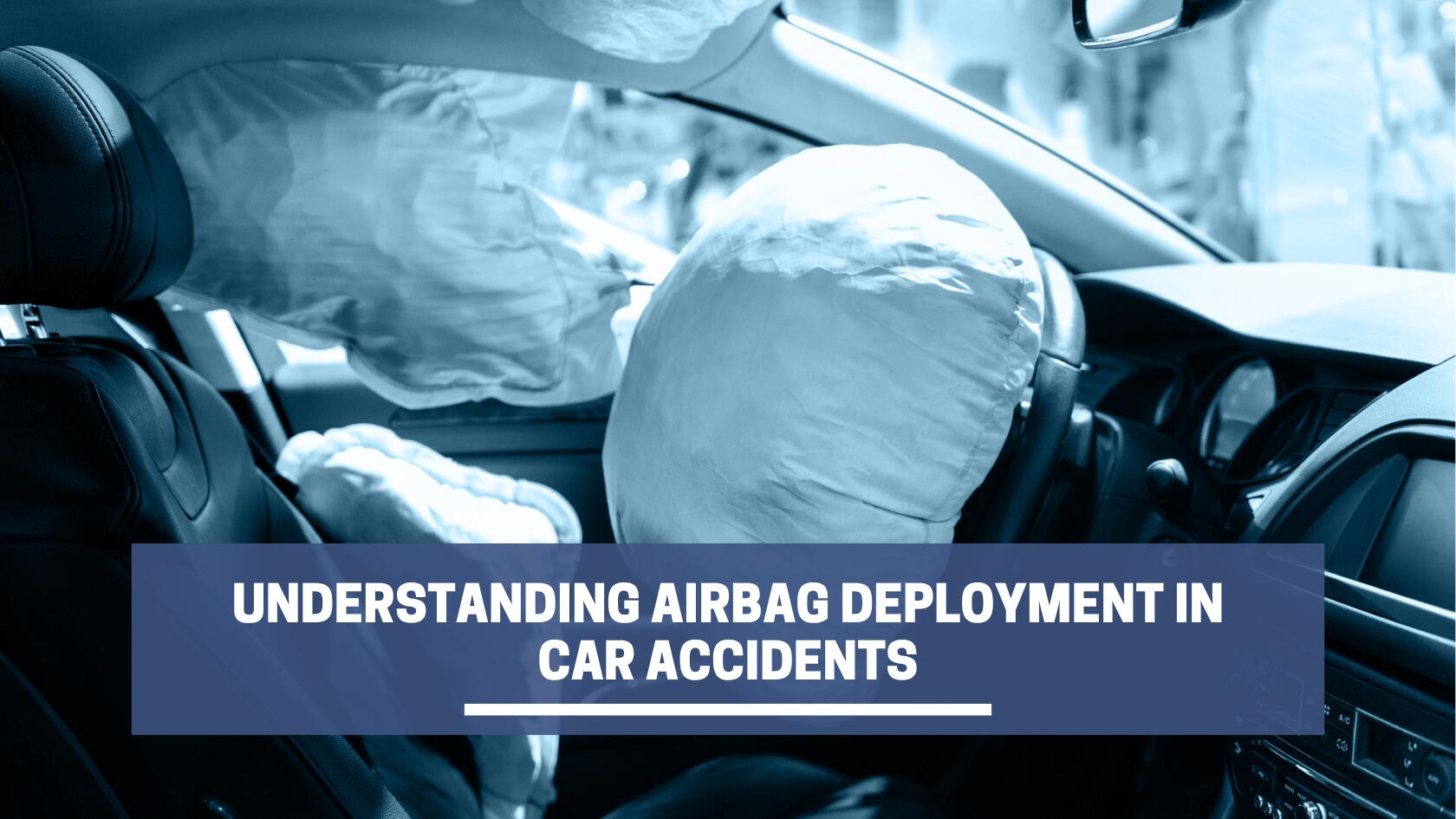Las bolsas de aire son una de las características de seguridad más reconocibles en los vehículos modernos. Requerido en todos los autos nuevos desde 1999, Se inflan en milisegundos durante accidentes moderados a severos para ayudar a prevenir lesiones que amenazan la vida..
Según la Administración Nacional de Seguridad del Tráfico en Carreteras (NHTSA), Los airbags delanteros se han guardado mas que 50,000 vidas en el pasado 30 años. Desafortunadamente, No siempre funcionan como se esperaba.
En algunos accidentes, Las bolsas de aire causan lesiones como quemaduras o huesos rotos, Especialmente en vehículos más antiguos. En otros, No se despliegan en absoluto por problemas de sensor, fallas de software, o cómo ocurrió el choque. Cuando fallan en los airbags, Las personas a menudo se quedan gravemente heridas e inseguras por qué el sistema no funcionó.
Si te lesionaste en un accidente de California, La implementación de la bolsa de aire puede afectar la falla y cómo se maneja su reclamo. Aprenda cuando se abran los airbags, quien puede ser responsable Cuando ocurre el daño, y cómo un abogado puede ayudar con su caso.
Por los números: Estadísticas de airbag
Las bolsas de aire son altamente efectivas para prevenir lesiones fatales en accidentes graves, Pero también pueden causar daño cuando se despliegan con demasiada fuerza o en condiciones incorrectas. Esto es lo que muestra la investigación:
- Las bolsas de aire bajan la riesgo de muerte por 29% para conductores en choques frontales y 32% Para los pasajeros de los asientos delanteros envejecidos 13 y.
- El uso de un cinturón de seguridad y una bolsa de aire reduce el riesgo de muerte en los choques frontales por 61%.
- Airbags laterales menores riesgo de muerte por 37% en autos y 52% en SUVS.
- Las airbags de cabeza y torsos reducen el riesgo de mortalidad hasta hasta 31% en el lado cercano Choques de T-bone.
- Entre 1990 y 2008, mas que 290 Las muertes se vincularon con la inflación de las bolsas de aire en accidentes de baja velocidad.
- Encima 90% de esas muertes involucradas a niños, pasajeros no fallados, o gente sentada demasiado cerca del airbag.
Desde finales de la década de 1990, La tecnología del airbag ha cambiado debido a los sistemas de sensores mejorados y los estándares federales de seguridad más estrictos. Comprender cómo funcionan estos sistemas ayuda a explicar por qué se activan los airbags, y por qué a veces no.
Cómo funcionan las bolsas de aire
Las bolsas de aire dependen de los sensores colocados en todo el vehículo para detectar una desaceleración repentina o impacto. Cuando esos sensores detectan un bloqueo que cumple con el umbral del sistema, Envían una señal a la unidad de control del airbag.
Esa señal desencadena una reacción química dentro del inflador. En la mayoría de los sistemas, un compuesto como azida de sodio reacciona para producir gas nitrógeno, que llena la bolsa de aire casi al instante. La velocidad de despliegue de la bolsa de aire es rápida, generalmente dentro 10 a 50 milisegundos.
El airbag estalla a través de su compartimento, generalmente en el volante, panel, o paneles laterales, y se expande para amortiguar al ocupante antes de desinflar rápidamente a través de pequeños respiraderos.
Debido a la fuerza involucrada, Las bolsas de aire pueden causar lesiones, especialmente si la persona está demasiado cerca cuando se infla o no está correctamente restringida.
¿Cuándo se implementan airbags??
Las bolsas de aire no se disparan cada vez que su automóvil golpea algo. Están diseñados para responder solo en condiciones específicas que indican un mayor riesgo de lesiones..
A continuación se presentan los umbrales de implementación de la bolsa de aire para diferentes Tipos de choques:
| Condición de choque | Despliegue de velocidad típico | Notas |
| Choque frontal (No fallecido) | 10-12 mph | Umbral inferior ya que ningún cinturón de seguridad está proporcionando restricciones. |
| Choque frontal (Ceñido) | Alrededor 16 mph | Umbral más alto porque el cinturón de seguridad ofrece protección a velocidades más bajas. |
| Accidente lateral (Objeto estrecho) | 8 mph | Se aplica a los polos, árboles, o objetos similares de impacto directo. |
| Accidente lateral (Impacto del vehículo) | 18 mph | Distribución de fuerza más amplia de otro automóvil o SUV en un Colisión T-Bone. |
| Mirando o impacto en ángulo | Varía | Puede no activar sensores si el bloqueo no es lo suficientemente directo o contundente. |
| Detección | Varía | Los airbags de cortina pueden desplegarse si se activan los sensores de vuelco. |
El despliegue depende no solo de la velocidad sino también de cómo y dónde se golpea el vehículo. Algunas veces, El airbag puede no inflarse, Incluso cuando ocurre un evento de activación.
Por qué las bolsas de aire pueden no desplegarse
Si su airbag no se desplegó en un bloqueo, No significa automáticamente que el accidente fue menor o el sistema falló. Las razones comunes de los airbags fallan durante los accidentes incluyen:
- Impacto de baja velocidad. Si el accidente no cumplió con el umbral de implementación, especialmente con un cinturón de seguridad, El airbag puede no activarse.
- Ángulo de colisión. Los impactos fuera del centro o lateral pueden no activar los sensores, Incluso si el daño parece grave.
- Choque trasero. Las airbags frontales no se despliegan en la mayoría colisiones de impacto traseras Porque la fuerza no se dirige hacia adelante.
- Mal funcionamiento del sensor. Los problemas eléctricos o los sensores defectuosos pueden evitar el despliegue incluso cuando debe ocurrir.
- Sistema discapacitado. Algunas bolsas de aire de pasajeros pueden apagarse manualmente, especialmente en vehículos con configuraciones de seguridad para niños.
- Implementación previa o problema de retiro. Una bolsa de aire desplegado o defectuosa previamente (Como los involucrados en el Takata Record) podría no responder en un segundo accidente.
Incluso si las bolsas de aire no se despliegan, aún puede sufrir heridas graves. La ausencia de despliegue no descarta una fuerte reclamación de lesiones en el airbag.
Implicaciones legales del despliegue de airbag
El despliegue de la bolsa de aire puede influir en cómo las aseguradoras y los abogados evalúan la culpa, gravedad de la lesión, y posible compensación por las víctimas de accidentes. Pueden analizarlo para determinar factores como:
Fuerza e impacto de choque
Si suena un airbag puede ayudar a indicar qué tan grave fue el impacto. Un airbag desplegado a menudo sugiere que el choque involucró una fuerte fuerza hacia adelante o lateral, Posiblemente a velocidades más altas.
En algunos casos, También puede ayudar a reconstruir lo que sucedió y mostrar qué conductor probablemente causó la colisión.
Severidad de lesiones y daños
La presencia o ausencia de despliegue puede ayudar a explicar los tipos de lesiones involucradas. Las bolsas de aire pueden causar quemaduras o fracturas, Pero también evitan un trauma mucho peor.
Si un airbag no se despliega, puede ayudar a explicar lesiones graves como trauma en la cabeza o huesos rotos, y apoyar un reclamo por mayores costos médicos, dolor y sufrimiento, o necesidades de tratamiento a largo plazo.
Responsabilidad del fabricante
Si una bolsa de aire no se abre cuando debería o se infla incorrectamente, la causa puede ser un defecto. Es posible que tenga un reclamo separado contra el fabricante o el proveedor de airbag en esos casos..
Debajo Ley de California, Una característica de seguridad defectuosa que contribuye a una lesión puede conducir a una compensación adicional más allá de un reclamo de lesiones típica.
Para demostrar cómo la bolsa de aire afectó sus lesiones, o si un defecto desempeñó un papel, necesitará tomar medidas específicas para reunir evidencia y proteger sus derechos después del accidente.
Pasos a tomar después de un accidente
Si has estado en un choque que involucra un airbag, Lo que hace a continuación puede afectar su salud y su capacidad para recuperar los daños.. Tomar estos pasos:
- Obtenga ayuda médica de inmediato. Algunas lesiones, como lesiones cerebrales traumáticas o daño interno—No muestra síntomas de inmediato. Obtener atención médica inmediatamente crea un registro claro que respalde su reclamo.
- Tomar fotos. Documentar la airbag, Incluyendo lo completamente inflado, Cualquier quemadura visible, y daño al interior. Capturar el exterior del vehículo, la escena del choque, Otros vehículos involucrados, y cualquier lesión física.
- Deje intacto el sistema de airbag. Antes de hacer cualquier reparación, Lleva el auto a un concesionario, centro de colisión, o experto en choque. Una inspección adecuada puede ayudar a determinar si el sistema no funcionó mal y puede ser esencial en un caso de responsabilidad del producto.
- Habla con un abogado defectuoso de la lesión en el airbag. Las reclamaciones legales que involucran bolsas de aire a menudo requieren una revisión técnica y una fuerte documentación. Un hábil abogado de airbag de accidente automovilístico maneja las comunicaciones con las aseguradoras, evalúa los posibles defectos, y construye un caso para una compensación completa.
Estos casos son técnicos y complejos: un experimentado abogado de lesiones por accidentes automovilísticos en California puede ayudarlo a buscar una compensación completa.
Herido en un accidente que involucra el despliegue de airbag? Póngase en contacto con un abogado hoy
Una bolsa de aire puede protegerlo o causar daños graves. Si el tuyo se despliega o falló cuando lo necesitaba más, Puede tener derecho a la recuperación financiera.
En el bufete de abogados Shirvanian, Ayudamos a las víctimas de accidentes automovilísticos en toda California a buscar reclamos por lesiones que involucren el despliegue de airbag, falla, o defectos. Nuestro equipo revisará el accidente, Investigar la posible responsabilidad, y luchar por el valor total de sus costos médicos, la pérdida de ingresos, y otros daños.
Póngase en contacto con nosotros hoy para una consulta gratuita para discutir sus próximos pasos y aprender lo que vale su reclamo.
Preguntas frecuentes
¿Qué hace que las bolsas de aire se despliegan??
Las bolsas de aire se disparan cuando los sensores del automóvil recogen una parada repentina o un fuerte impacto, Por lo general, el tipo que verías en un choque moderado o severo. El sistema reacciona en milisegundos para ayudarlo a protegerlo antes de golpear el volante o el lado del automóvil.
¿Qué tan rápido tiene que ir a implementar airbags para desplegar??
Las airbags delanteras generalmente se inflan a velocidades entre 10 y 16 mph, dependiendo del uso del cinturón de seguridad y la construcción del automóvil. Las airbags laterales pueden activarse a velocidades más bajas, especialmente si el accidente ocurre cerca del costado del vehículo.
Referencias externas
https://www.nhtsa.gov/vehicle-safety/air-bags
https://www.iihs.org/topics/airbags










